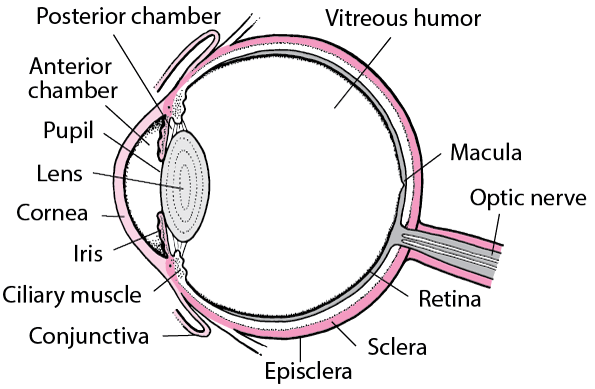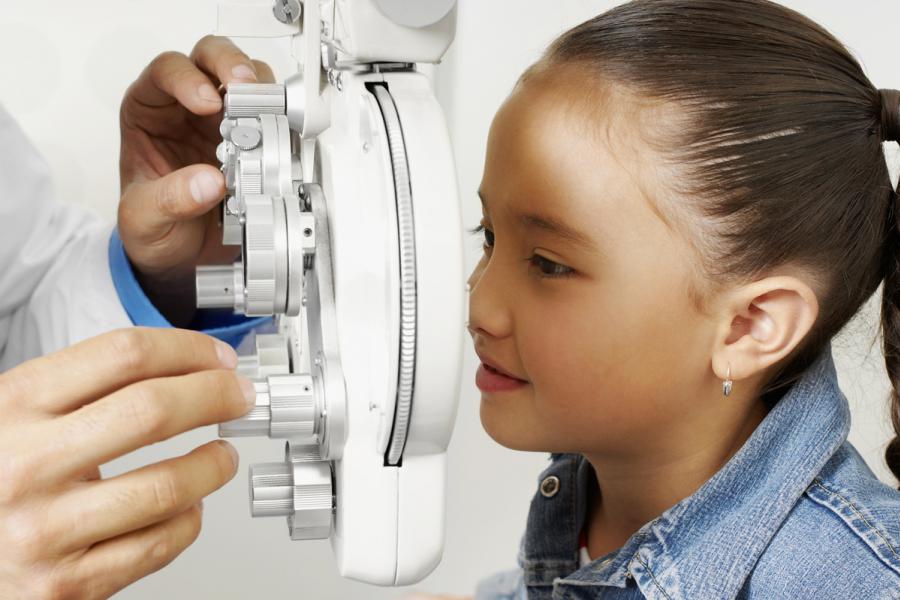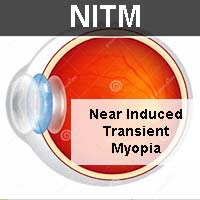What is a transient myopia?
Notes that after viewing at near distances for several hours, observers may become temporarily myopic. This effect, known as transient myopia after visual work, was studied by measuring contrast sensitivity to a sinusoidally modulated grating pattern.
Prolonged activities such as reading, writing, using computers, tablets, and smartphones without resting the eyes can cause the eye muscles to remain contracted, leading to blurred distance vision. This condition is what we refer to as pseudomyopia.
Pseudomyopia (from ψεῦδο, "pseudo": false; and μυωπία "myopia": near sight
Pseudomyopia is an inappropriately excessive accommodation of the eye due to overstimulation or ciliary spasm, which leads to a marked approximation of the far point.

Most people do not understand "pseudomyopia". Pseudomyopia is generally easy to appear in childhood, and parents simply think that pseudomyopia does not need to be dealt with, and the child's vision will automatically recover after a period of rest. Most parents still take a fluke and think that their children are still young, which must be pseudo-myopia, and there is no need to specifically check them, but in fact, this practice actually delays the children.
"Pseudo-myopia" does not belong to the true sense of myopia. It is actually a type of ciliary muscle that is continuously contracted and spasm due to excessive adjustment, and the thickness of the lens increases, so that the image of the object is in front of the retina, because its symptoms are the same as myopia. But it is essentially different from myopia, so it is called "pseudo-myopia".
Pseudo-myopia is a functional abnormality and is reversible!

Transient myopia, which can also be called accommodative spasm or pseudomyopia, occurs when the accommodative system is not relaxed, making a patient falsely seem to need more minus lens correction power.
Nearwork-induced transient myopia (NITM), a lenticular-based pseudomyopia, is commonly found in myopic teenagers and young adults. It has been speculated that its presence may be a factor in nearwork-related symptoms and in the development of permanent myopia.
What is anxiety?
Feeling anxious is a normal part of life.
Many people worry about things such as health, money, school, work, or family. But anxiety disorders involve more than occasional worry or fear. For people with these disorders, anxiety does not go away, is felt in many situations, and can get worse over time.
Common symptoms of pseudomyopia include eye strain or fatigue, and it is classified as organic or functional.

The latter is due to eye strain and functional increase in the ciliary tonus. Pseudomyopia can vary from being a transient condition or continue to progress to myopia. Head trauma is the most common cause followed by psychiatric illnesses, neurologic diseases, and drug-induced causes. There is an association between psychological stress-inducing events and pseudomyopia as it affects the autonomic nervous system. The human body counteracts anxiety by activating the parasympathetic nervous system, causing ciliary muscle contraction.
What is the cause of pseudomyopia?
Pseudomyopia or accommodative spasm occurs because of excessive constriction of the ciliary muscle which clinically manifests as blurred vision, distorted image, photophobia, and ocular pain. Symptoms are variable and can be unilateral or bilateral and constant or episodic

What is the difference between myopia and pseudo myopia?
- Myopia is a major health problem leading to significant public health and economic concerns, especially in Asia.
Pseudomyopia refers to spherical equivalent (SE) ≤−0.50 diopters (D) before cycloplegia and >−0.50D after cycloplegia, and nearly 24.1% of Chinese children were found to have pseudomyopia.
Whether the presence of pseudomyopia affects the risk of myopia remains unknown.

The following symptoms may be seen in patients with pseudomyopia:
- + Blurring of distance vision: Intermittent blurring of distant vision after prolonged near work is the main symptom of pseudomyopia.
- - Esotropia: Acute onset esotropia may occur in accommodative spasm, which is the common cause of pseudomyopia.
- - Diplopia: Diplopia may occur due to esotropia or convergence spasm
- + Asthenopia

Eye Strain Can Cause Pseudomyopia - - Headache
- + Eyestrain
- - Photophobia
The diagnosis is done by cycloplegic refraction using a strong cycloplegic like atropine or homatropine eye drops. Accommodative amplitude and facility may be reduced as a result of the ciliary muscle spasm.
There is a close correlation between unaided distance visual acuity and myopia; however, this correlation is not maintained in the presence of pseudomyopia, while pseudomyopia maybe presented as decrement of distance visual acuity.
Underlying psychiatric diseases in pseudomyopia patients have been reported in the past in multiple studies. Generalized anxiety disorder is the most common psychiatric illness associated with pseudomyopia with a positive correlation between anxiety-somatization scores and accommodation amount of the eye.


It is strongly advised that a psychiatric consultation should be included in the multidisciplinary evaluation of every case. If patients have coexisting anxiety disorders, a multidisciplinary approach using psychiatric consultations, work environment changes, ocular exercises, and cycloplegic drugs can be used.
This review aims to shed light on the association of psychiatric disorders such as anxiety with pseudomyopia. eResearch by Navid Ajamin -- winter 2025
Do you need glasses for pseudomyopia?
Treatment may include various eye drops or prescription glasses. The duration of treatment for pseudomyopia varies from patient to patient.”
Is pseudomyopia permanent?
In optometry, this shows nearsightedness, but it is not permanent. In most cases pseudomyopia occurs in children between the age of six years old through adolescence. It is less common after that age. In adults, pseudomyopia is rare because the gazing mechanism, so common in children, diminishes as people age.

What is the difference between myopia and degenerative myopia?
Degenerative myopia is typically a consequence of high myopia, a severe degree of nearsightedness. However, degenerative myopia is not merely a degree of myopia but is a distinct form characterized by specific degenerative changes occurring at the back of the eye.
Which drug produces transient myopia?
Drugs known to produce this effect include sulfa drugs and other medications. The possible mechanism is thought to be an allergic reaction to the drug. Both ciliary muscle contraction and ciliary body edema may play role in the pathomechanism.
- - Transient Myopia After Acetazolamide
- - Transient Myopia Due to Tetracycline
Can pseudomyopia turn into real myopia?
Based on a large prospective population-based cohort study, we found that pseudomyopia was an independent risk factor for myopia development among school-aged children.

 Reference:
Reference:
- clarksoneyecare.com/eye-care-treatments/myopia-treatment/what-is-degenerative-myopia
- kudretgozistanbul.com/en/Blog/eye-diseases-1/eye-strain-can-cause-pseudomyopia
- cureus.com/articles/68472-pseudomyopia-and-its-association-with-anxiety#!
- mikeoptical.com/newsdetail/what-is-pseudomyopia%20111.html
- sciencedirect.com/science/article/abs/pii/S0953443198000241
- scholarena.com/article/Transient-Drug-Induced-Myopia.pdf
- endmyopia.org/how-to-improve-eyesight-without-surgery
- bumrungrad.com/en/health-blog/january-2015/q-a-eye
- visionscienceacademy.org/anxiety-and-visual-distress
- myopiaprofile.com/articles/what-is-pseudomyopia
- nimh.nih.gov/health/topics/anxiety-disorders
- pmc.ncbi.nlm.nih.gov/articles/PMC8459808
- anrri.com/blogs/education/pseudomyopia
- bmjophth.bmj.com/content/8/1/e001122
- psycnet.apa.org/record/1985-13345-001
- en.wikipedia.org/wiki/Pseudomyopia
- bjo.bmj.com/content/108/6/873
- peerj.com/articles/16941
- eyeconsee.com/myopia
See also:
- The association between nearwork-induced transient myopia and progression of refractive error
- Transient Myopia Associated with Anterior Displacement of the Crystalline Lens
- Treatment of spasm of accommodation (false myopia)
- Nearwork-induced transient myopia: a critical review
 وبلاگ تخصصی عینک شامل مجموعه مطالب پزشکی است که اطلاعات مفیدی در رابطه با عینک , چشم، لنز، سلامتی چشم و راه های پیشگیری از بیماریهای چشمی، کنترل و درمان آن را در اختیار شما کاربر محترم می گزارد.
وبلاگ تخصصی عینک شامل مجموعه مطالب پزشکی است که اطلاعات مفیدی در رابطه با عینک , چشم، لنز، سلامتی چشم و راه های پیشگیری از بیماریهای چشمی، کنترل و درمان آن را در اختیار شما کاربر محترم می گزارد.